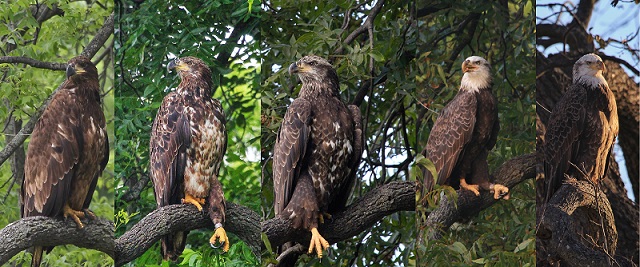By Bree Dunham, CPN Eagle Aviary
The weather finally feels like spring here in Oklahoma. All the birds at the aviary seem to know that winter has completely given way and that we have surely seen our last frost of the season. The ruby-throated hummingbirds arrived the first week of April and there are scissor-tailed flycatchers perched in pairs along the highline wires lining the driveway.
The pair of Canadian geese who nested in the front pecan tree in past years has returned to nest again. Today the mother is sitting higher in the nest than usual and the father seems to be more protective of his space than in days past, even chasing off doves that land near the tree. This is a good indication that goslings are hatching. They will stay in the nest until they all hatch and the following day they will make the incredible jump to the ground to follow their parents to the creek. The great-horned owls that have previously nested in the big pecan hollow out back unfortunately did not return this year but for the first time since the aviary’s construction, the turkey hens have laid eggs and have begun incubating in the pasture.

Although Wadasé Zhabwé hasn’t been back to the aviary since the first week in February she has been busy this spring as well. She continues to frequent the area around Horseshoe Lake near Harrah but within the last few weeks a new place has gained her attention. There are several reservoir sites less than 20 miles north of the aviary between highways 102 and 177 that she has taken an interest in recently. Wadasé has recorded dozens of points near several small bodies of water listed as Quawpaw Reservoirs in an average of 12 square miles of territory. Although that is a relatively small area when talking about the range she can now travel, we still have had little success in spotting her after checking telemetry and traveling directly to those locations.
The main obstacle in locating her continues to be limited access into where she frequents. Since her release she has consistently chosen to stay in areas where there are very few people and access points. But those trips to the new locations weren’t completely unsuccessful. We have had the chance to meet some great people and talk to several landowners. We even spoke with a few who think they may have seen her fishing in the reservoirs. Armed with new information and a recent photo of Wadasé, they will hopefully be able to provide positive sightings and new information in the future about her behavior in the wild.
As Wadasé molts this spring, the feathers that are replaced on her head and tail will be nearly all white. Although it is hard not to think of her as that young eagle we first received, at that time named Penojés, she is now a young adult. This next year will be spent defining her summer territory. When fall rolls around she will choose a mate. Together, they will choose a nest site and build a nest that they will return to each year. First year nests tend not to be successful in producing young, but it isn’t completely out of the question. She continues to prove the odds are in her favor.
We will continue to check her telemetry every three days. However, those days in between seem to take forever to pass by. When the time comes to finally download the information, we are as nervous as we were waiting on the first batch of telemetry data when Wadasé was initially released.
We know that her GPS backpack has functioned much longer than we ever imagined and now we are just holding our breath, hoping and praying, for the unit to provide us telemetry into nesting season. We are so thankful for all the data and all that we have learned, but we know we are closer to the end of that data-gathering period than we are the beginning. We hope to be able to continue to share Wadasé’s story through many more seasons and generations.
As always we encourage you to keep your eyes out for Wadasé if you are near the areas she frequents. For more information about the CPN Eagle Aviary or to read previous Wadasé updates visit www.potawatomiheritage.org.
Send your encounters with Wadasé or any other eagles in Oklahoma or wherever you may be to us at aviary@potawatomi.org.
